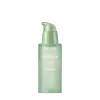What's inside
What's inside
 Key Ingredients
Key Ingredients

 Benefits
Benefits

 Concerns
Concerns

No concerns
 Ingredients Side-by-side
Ingredients Side-by-side

Water
Skin ConditioningMethylpropanediol
SolventDipropylene Glycol
Humectant1,2-Hexanediol
Skin ConditioningGlycerin
HumectantGlycereth-26
HumectantAcrylates/C10-30 Alkyl Acrylate Crosspolymer
Emulsion StabilisingPPG-13-Decyltetradeceth-24
EmulsifyingTromethamine
BufferingAspergillus/Buckwheat Ferment Extract
AntioxidantCitric Acid
BufferingDisodium EDTA
Rosmarinus Officinalis Leaf Oil
MaskingButylene Glycol
HumectantAllantoin
Skin ConditioningEthylhexylglycerin
Skin ConditioningBetula Platyphylla Japonica Juice
Skin ConditioningMadecassoside
AntioxidantAsiaticoside
AntioxidantTocopherol
AntioxidantCentella Asiatica Extract
CleansingCornus Walteri Leaf Extract
Skin ConditioningMadecassic Acid
Skin ConditioningAsiatic Acid
Skin ConditioningWater, Methylpropanediol, Dipropylene Glycol, 1,2-Hexanediol, Glycerin, Glycereth-26, Acrylates/C10-30 Alkyl Acrylate Crosspolymer, PPG-13-Decyltetradeceth-24, Tromethamine, Aspergillus/Buckwheat Ferment Extract, Citric Acid, Disodium EDTA, Rosmarinus Officinalis Leaf Oil, Butylene Glycol, Allantoin, Ethylhexylglycerin, Betula Platyphylla Japonica Juice, Madecassoside, Asiaticoside, Tocopherol, Centella Asiatica Extract, Cornus Walteri Leaf Extract, Madecassic Acid, Asiatic Acid
Houttuynia Cordata Extract
Skin ConditioningGlycerin
HumectantWater
Skin ConditioningMethylpropanediol
SolventDipropylene Glycol
HumectantGlycereth-26
HumectantChondrus Crispus Extract
Skin ConditioningSaccharum Officinarum Extract
MoisturisingMentha Aquatica Extract
TonicSodium Hyaluronate
HumectantGaultheria Procumbens Leaf Extract
PerfumingButylene Glycol
HumectantHydroxyethyl Urea
HumectantPanthenol
Skin ConditioningAmmonium Acryloyldimethyltaurate/Vp Copolymer
Acrylates/C10-30 Alkyl Acrylate Crosspolymer
Emulsion StabilisingTromethamine
BufferingCaprylyl Glycol
EmollientSuccinic Acid
Buffering1,2-Hexanediol
Skin ConditioningXanthan Gum
EmulsifyingHouttuynia Cordata Extract, Glycerin, Water, Methylpropanediol, Dipropylene Glycol, Glycereth-26, Chondrus Crispus Extract, Saccharum Officinarum Extract, Mentha Aquatica Extract, Sodium Hyaluronate, Gaultheria Procumbens Leaf Extract, Butylene Glycol, Hydroxyethyl Urea, Panthenol, Ammonium Acryloyldimethyltaurate/Vp Copolymer, Acrylates/C10-30 Alkyl Acrylate Crosspolymer, Tromethamine, Caprylyl Glycol, Succinic Acid, 1,2-Hexanediol, Xanthan Gum
 Reviews
Reviews

Ingredients Explained
These ingredients are found in both products.
Ingredients higher up in an ingredient list are typically present in a larger amount.
1,2-Hexanediol is a synthetic liquid and another multi-functional powerhouse.
It is a:
- Humectant, drawing moisture into the skin
- Emollient, helping to soften skin
- Solvent, dispersing and stabilizing formulas
- Preservative booster, enhancing the antimicrobial activity of other preservatives
Acrylates/C10-30 Alkyl Acrylate Crosspolymer is a synthetic polymer. It is used to thicken and improve the texture of products. Due to its properties, it can prevent water and oil ingredients from separating.
Butylene Glycol (or BG) is used within cosmetic products for a few different reasons:
Overall, Butylene Glycol is a safe and well-rounded ingredient that works well with other ingredients.
Though this ingredient works well with most skin types, some people with sensitive skin may experience a reaction such as allergic rashes, closed comedones, or itchiness.
Learn more about Butylene GlycolDipropylene Glycol is a synthetically created humectant, stabilizer, and solvent.
This ingredient helps:
Dipropylene glycol is technically an alcohol, but it belongs to the glycol family (often considered part of the ‘good’ alcohols). This means it is hydrating and gentle on skin unlike drying solvent alcohols like denatured alcohol.
As a masking agent, Dipropylene Glycol can be used to cover the smell of other ingredients. However, it does not have a scent.
Studies show Dipropylene Glycol is considered safe to use in skincare.
Learn more about Dipropylene GlycolGlycereth-26 is a synthetic ingredient and polyethylene glycol ether of Glycerin. Glycerin is already naturally found in your skin and helps keep your skin moisturized.
It is a humectant and helps add texture to products. It can make your product thicker.
As a humectant, it helps draw moisture from the air to your skin. This helps your skin stay hydrated.
Learn more about Glycereth-26Glycerin is already naturally found in your skin. It helps moisturize and protect your skin.
A study from 2016 found glycerin to be more effective as a humectant than AHAs and hyaluronic acid.
As a humectant, it helps the skin stay hydrated by pulling moisture to your skin. The low molecular weight of glycerin allows it to pull moisture into the deeper layers of your skin.
Hydrated skin improves your skin barrier; Your skin barrier helps protect against irritants and bacteria.
Glycerin has also been found to have antimicrobial and antiviral properties. Due to these properties, glycerin is often used in wound and burn treatments.
In cosmetics, glycerin is usually derived from plants such as soybean or palm. However, it can also be sourced from animals, such as tallow or animal fat.
This ingredient is organic, colorless, odorless, and non-toxic.
Glycerin is the name for this ingredient in American English. British English uses Glycerol/Glycerine.
Learn more about GlycerinMethylpropanediol is a synthetic solvent and humectant.
As a solvent, it helps dissolve other ingredients, helping to evenly distribute ingredients throughout the product. This ingredient has also been shown to have antimicrobial properties which makes it a preservative booster.
Methylpropanediol is able to add a bit of moisture to the skin. It also helps other ingredients be better absorbed into the skin, such as salicylic acid.
Learn more about MethylpropanediolTromethamine helps balance the pH and improve the texture of a product. It is synthetically created.
As an emulsifier, Tromethamine prevents oil and water ingredients from separating. This helps stabilize the product and elongate a product's shelf life. Tromethamine also makes a product thicker.
Tromethamine helps balance the pH level of a product. Normal pH level of skin is slightly acidic (~4.75-5.5). The acidity of our skin is maintained by our glands and skin biome. Being slightly acidic allows our skin to create an "acid mantle". This acid mantle is a thin barrier that protects our skin from bacteria and contaminants.
Oral Tromethanmine is an anti-inflammatory drug but plays the role of masking, adding fragrance, and/or balancing pH in skincare.
1,3-Propanediol, 2-amino-2-(hydroxymethyl)-
Learn more about TromethamineWater. It's the most common cosmetic ingredient of all. You'll usually see it at the top of ingredient lists, meaning that it makes up the largest part of the product.
So why is it so popular? Water most often acts as a solvent - this means that it helps dissolve other ingredients into the formulation.
You'll also recognize water as that liquid we all need to stay alive. If you see this, drink a glass of water. Stay hydrated!
Learn more about Water